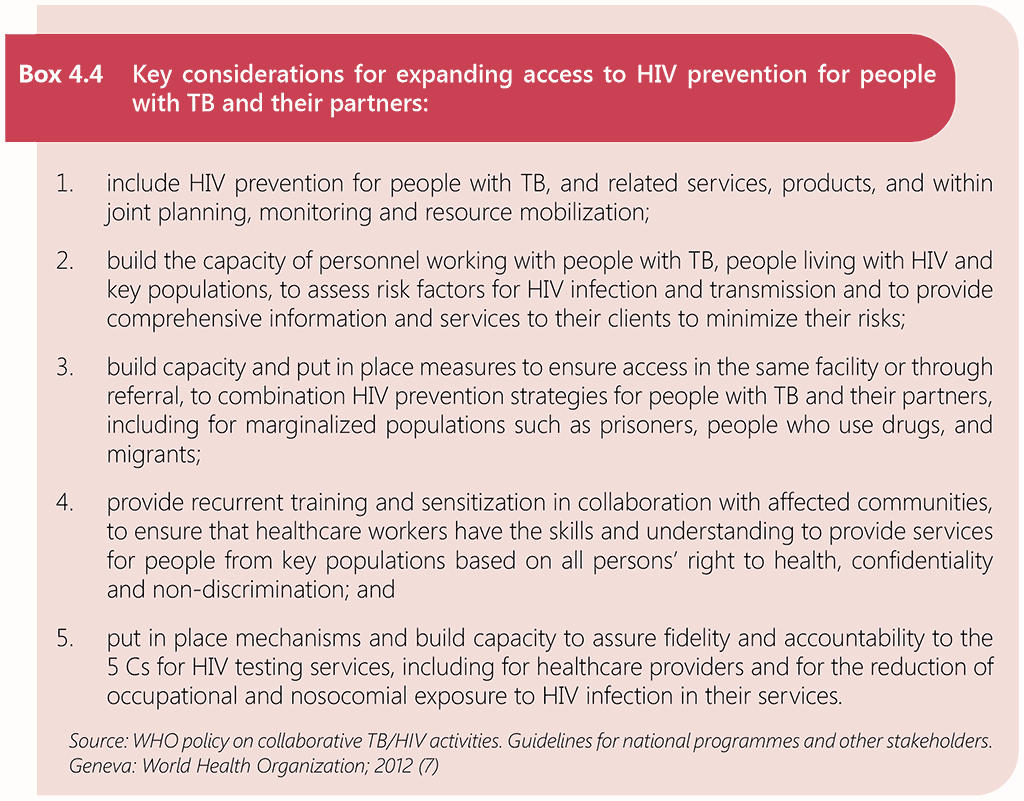Liens transversaux de livre pour 4.3 HIV prevention
4.3.1 Combination HIV prevention for people with diagnosed or presumed TB
National TB programmes should implement comprehensive HIV prevention strategies for their clients and their partners, or they should establish community and referral linkages as necessary. HIV preventive interventions by TB programmes or effective referral of people with TB to HIV programmes has been successfully implemented in many countries (162-164).
Combination prevention programmes use a mix of evidence-based biomedical, behavioural and structural interventions to meet the current HIV prevention needs of individuals and communities, to have the greatest possible impact on reducing the number of people newly infected. Well-designed combination prevention programmes need to reflect the local HIV epidemiology and context. They should focus resources to reach populations at greatest HIV risk with effective, acceptable prevention to address both immediate risks and underlying vulnerabilities. Combination prevention mobilizes communities, civil society, the private sector, governments, and global resources in a collective undertaking. It requires and benefits from enhanced partnership and coordination and should incorporate mechanisms for learning, capacity-building and flexibility, to permit continual improvement and adaptation to the changing epidemiological environment. This section summarizes key aspects of HIV prevention, which will also benefit people with presumed and diagnosed TB. A comprehensive overview of HIV prevention interventions is provided in the Consolidated guidelines on HIV prevention, testing, treatment, service delivery and monitoring: recommendations for a public health approach (17).
To maximize HIV prevention for people with diagnosed TB and their partners, TB programmes should collaborate with HIV programmes and affected communities. Key considerations are listed in Box 4.4.

4.3.1.1 Biomedical interventions for HIV prevention
Antiretroviral drugs play a key role in HIV prevention. People taking ART who achieve viral suppression (<200 copies/mL) do not transmit HIV to sexual partners. ART also plays a key role in the prevention of vertical (mother to child) transmission of HIV during pregnancy, delivery and breastfeeding. Antiretroviral drugs taken by people without HIV as PrEP and post-exposure prophylaxis are both highly effective in preventing HIV acquisition.
Harm reduction for people who inject drugs is provided through a range of interventions and services that can critically reduce transmission of HIV as well as other blood-borne viruses such as hepatitis C. Needle and syringe programmes are highly effective in reducing HIV and hepatitis C transmission through injecting drug use (165). Opioid agonist maintenance therapy with methadone or buprenorphine is the most effective form of treatment for opioid dependence and has the additional benefit of effectively reducing HIV transmission through injecting drug use. OAMT is also effective in improving ART uptake and adherence for people dependent on opioids (126, 166). Individuals receiving methadone or buprenorphine together with rifampicin should, however, be monitored closely, and those who experience opioid withdrawal should have their methadone or buprenorphine dose adjusted according to their needs. Rifabutin can be used as an alternative to rifampicin; rifabutin has not been documented to significantly affect buprenorphine or methadone levels (96). For people who inject drugs during sex (“chemsex”), integrated sexual health, mental health and substance use services, with linkages to evidence-based prevention interventions, should be provided. National TB programmes should coordinate closely with HIV services and harm reduction services to ensure continued access to HIV prevention during and after TB treatment. Such linkages can be facilitated with the help of NGOs and community-led organizations.
Other biomedical interventions that reduce HIV risk practices and/or the probability of HIV transmission per contact event include male and female condoms and condom-compatible lubricant (167-169), as well as voluntary medical male circumcision (170). In healthcare settings, transmission of HIV can be prevented through primary prevention measures such as standard precautions, injection safety, blood safety and safe waste disposal, as well as secondary prevention measures such as occupational post-exposure prophylaxis (7).
4.3.1.2 Behavioural and structural interventions for HIV prevention
Behavioural interventions can reduce the frequency of potential transmission events. Targeted information and education programmes use various communication approaches, such as school-based comprehensive sexuality education, peer counselling and community-level and interpersonal counselling (including brief interventions) to disseminate messages. Recognition is growing that social media and mobile technology are important tools that can be integrated in HIV prevention programmes and can be particularly critical in providing information and prevention services to key populations.
Enabling interventions to address structural barriers to accessing services may increase access to, uptake of and adherence to prevention, as well as testing and treatment services. Such interventions address the critical social, legal, political and enabling environment that contribute to HIV transmission, including legal and policy reform towards decriminalizing behaviour (such as drug use and same-sex sex) and sex work to reduce stigma and discrimination (including in the health sector), promoting gender equality and preventing gender-based violence and violence towards key populations, economic and social empowerment, access to schooling and supportive interventions designed to enhance referrals, adherence, retention and community mobilization.
WHO recommends a comprehensive package of evidence-based HIV-related interventions and services for all key populations. The package comprises health interventions and a set of critical enablers required for successful implementation of programmes and access for the five key populations, as outlined in Table 2.2 (Chapter 2).
 Retour
Retour